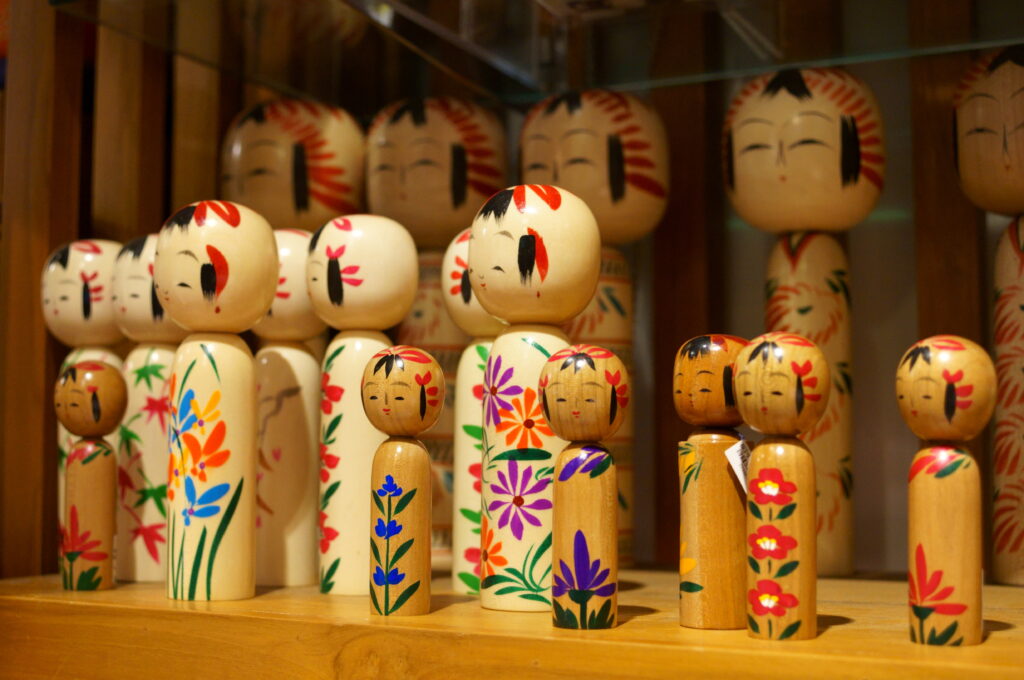Outline of “Kokeshi Dolls / ”こけし”の概要

Kokeshi dolls are wheel-thrown wooden doll toys that began to be sold as souvenirs to spa tourists in hot spring resorts in the Tohoku region around the end of the Edo period (Bunka-Bunsei period). It is one of Japan’s traditional handicrafts. Generally, the doll has a simple form with a spherical head and a cylindrical body. (from Wikipedia)
Kokeshi dolls originally originated in the Edo period (18th century) as souvenirs from hot spring resorts. At that time, Japan was still poor, and 90% of the population was engaged in agriculture. To relieve the fatigue of hard farm work, people enjoyed hot spring cures at hot spring resorts two or three times a year.
Wood craftsmen called “kijishi” were established in the hot spring resort, and it is said that the origin of kokeshi dolls is that the farmers who took a hot spring cure asked for kokeshi dolls as souvenirs.
Later, the souvenirs were given to children, and they became dolls for children to play with.
In Japanese folk tales, have you ever seen a girl carrying a cushion and a kokeshi doll on her back and playing with it as if she were playing with a denden-daiko? In those days, kokeshi dolls were playthings for Japanese children.
Today, kokeshi dolls are widely known not only as children’s toys but also as traditional Japanese wooden crafts representing Japan.
Kokeshi dolls were used as a good-luck talisman by the farmers who practiced hot-spring cures to connect with the gods of the mountains. Kokeshi dolls have grown up together with many children as their playmates.
This is exactly the symbol that fits the concept of this project, “to convey Japan to the world.
We sincerely hope that the Kokeshi NFT will be placed by your side, and that it will be an opportunity to invite you to Japan and its culture.
『こけし(小芥子)は、江戸時代後期(文化・文政期)頃から、東北地方の温泉地において湯治客に土産物として売られるようになった轆轤(ろくろ)挽きの木製の人形玩具。日本の伝統工芸品の一つである。一般的には、球形の頭部と円柱の胴だけのシンプルな形態をしている。』(Wikipediaより)
「こけし」は、もともと温泉地のお土産物として江戸時代(18世紀)に生まれました。当時の日本はまだ貧しく、国民の90%が農業を営んでいました。厳しい農作業の疲れを癒やすため、一年のうち2~3回温泉地での湯治を楽しんでいたそうです。
その温泉地には木地師と言われる木工職人も定着しており、湯治の農民たちが土産物として、こけしを求めたのが発祥と言われています。
その後、その土産物がこどもの手にわたり、こどもたちの遊び相手の人形になります。
日本の昔話で、女の子が座布団と「こけし」を背中に背負い、でんでん太鼓でをあやすようにおままごとをしている姿を見かけたことはないでしょうか?そのころのこけしは、日本のこどもたちの遊び相手でした。
今では、こどもの玩具としてではなく日本を代表する木工の伝統工芸品として、海外でも広く知られています。
湯治の農民が山の神とつながる縁起物としたこけし…。そして多くのこどもたちの遊び相手となって一緒に育ち成長してきたこけし…。
これはまさに、「日本を世界に伝えていく」というこのプロジェクトのコンセプトにピッタリのシンボルです。
こけしのNFT…ぜひあなたのそばにも一体置いて頂き、”Kokeshi NFT”があなたを日本の日本の風土や文化に誘うきっかけになることを心より願っています。

